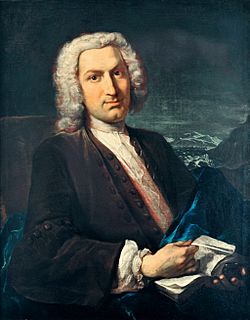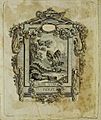Albrecht von Haller facts for kids
Quick facts for kids
Albrecht von Haller
|
|
|---|---|

Albrecht von Haller
|
|
| Born | 16 October 1708 Bern, Swiss Confederacy
|
| Died | 12 December 1777 (aged 69) Bern, Swiss Confederacy
|
| Nationality | Swiss |
| Scientific career | |
| Fields | Anatomist Physiologist Naturalist |
| Influences | Herman Boerhaave |
Albrecht von Haller (born October 16, 1708 – died December 12, 1777) was a brilliant Swiss scientist. He was an anatomist (someone who studies the body's structure), a physiologist (someone who studies how the body works), and a naturalist (someone who studies nature). Many people call him "the father of modern physiology" because of his important discoveries. He was also a poet, a writer of encyclopedias, and a bibliographer (someone who lists books).
Contents
Early Life and Amazing Talents
Albrecht von Haller was born in Bern, Switzerland. He was often sick as a child, so he couldn't play many sports. This gave him more time to read and learn. He was incredibly smart from a very young age!
A Child Prodigy
- At just four years old, he reportedly read and explained the Bible to his family's helpers.
- Before he turned ten, he had started writing a grammar book for an ancient language called Biblical Aramaic.
- He also created lists of words for Greek and Hebrew.
- He even wrote a collection of two thousand biographies of famous people.
- By age fifteen, he had translated poems from famous Roman writers like Ovid, Horace, and Virgil.
- He also wrote his own poems, plays, and a long poem about the history of Switzerland.
Becoming a Doctor and Scientist
Haller became interested in medicine after his father passed away in 1721. He was still quite shy and often unwell.
Studying Medicine
- In 1723, at age 16, he began studying at the University of Tübingen.
- He later moved to the University of Leiden in 1725. This was where Boerhaave, a very famous doctor, taught.
- Haller earned his medical degree in 1727. His main project for graduation proved that a supposed new discovery was actually just a blood vessel.
Understanding the Body: Sensibility and Irritability
In 1752, Haller made a huge discovery about how our bodies work. He explained the difference between "sensibility" and "irritability."
- Sensibility means that nerves allow us to feel things. For example, when you touch something, your nerves send signals to your brain, and you perceive it.
- Irritability means that muscles can react and shorten (contract) on their own. This happens even if you don't consciously feel it. For example, a muscle might twitch if something touches it, without you even realizing it at first.
How Nerves and Muscles Work
Later, in 1757, Haller did more experiments. These helped him show the clear differences between how nerve signals travel and how muscles contract. His work was key to understanding how our bodies move and react.
Exploring Other Fields
After finishing his medical studies, Haller traveled to learn even more.
Travels and New Interests
- He visited London and met important scientists like Sir Hans Sloane.
- He then went to Paris to study anatomy.
- In 1728, he studied advanced math in Basel with John Bernoulli.
- During this time, he also became very interested in botany, the study of plants.
- He took a trip through the Alps and started collecting plants. This collection later became the basis for his major book about Swiss plants.
The Poem Die Alpen
His trip to the Alps also inspired him to write a famous poem called Die Alpen (The Alps). This poem was one of the first to show how much people were starting to appreciate mountains. It also compared the simple, peaceful life of people in the Alps to the busy, sometimes difficult life in the cities.
Professor at Göttingen
- In 1729, Haller returned to Bern and started working as a doctor.
- But he spent most of his time on plant and body research. His work quickly made him famous across Europe.
- In 1736, King George II invited him to teach at the new University of Göttingen. He became a professor of medicine, anatomy, botany, and surgery.
- He became a member of the Royal Society in 1743 and was given a special title (ennobled) in 1749.
Busy Years in Göttingen
Haller did an incredible amount of work during his seventeen years at Göttingen.
- He helped set up a new botanical garden, an anatomy lab, a museum, and a school for childbirth.
- He kept doing his own research in botany and physiology.
- He also continued writing poetry.
- He even managed a monthly science journal, writing thousands of articles for it!
- Haller was a Christian and was very involved in religious discussions of his time. He helped build a church in Göttingen.
Even with all this, Haller missed his home in Bern. He decided to leave Göttingen in 1753 and return to Switzerland.
Contributions to Botany
Haller made important contributions to the study of plants. However, he didn't use the new naming system (called binomial nomenclature) that Carl Linnaeus introduced in 1753. This system is still used today to name plants and animals.
- A beautiful plant from Southern Africa, called Halleria, was named after him by Carl Linnaeus.
Later Life and Legacy
The last 21 years of Haller's life were spent working in a local government role in Bern. He also worked on his huge Bibliotheca medica (Medical Library), which listed many medical books.
- He wrote three philosophical stories: Usong (1771), Alfred (1773), and Fabius and Cato (1774). In these stories, he shared his ideas about different types of government, like rule by one person, a king with limited power, or a government run by a group of important people.
- Around 1773, his health got worse, and he had to stop his public work.
Albrecht von Haller was married three times and had eight children. Two of his sons, Gottlieb Emanuel and Albrecht, also became botanists.
Images for kids
See Also
 In Spanish: Albrecht von Haller para niños
In Spanish: Albrecht von Haller para niños
- Hallerian physiology, the theory named after Albrecht von Haller, as an alternative explanation to Galvanism
- Karl Ludwig von Haller, Haller's grandson




